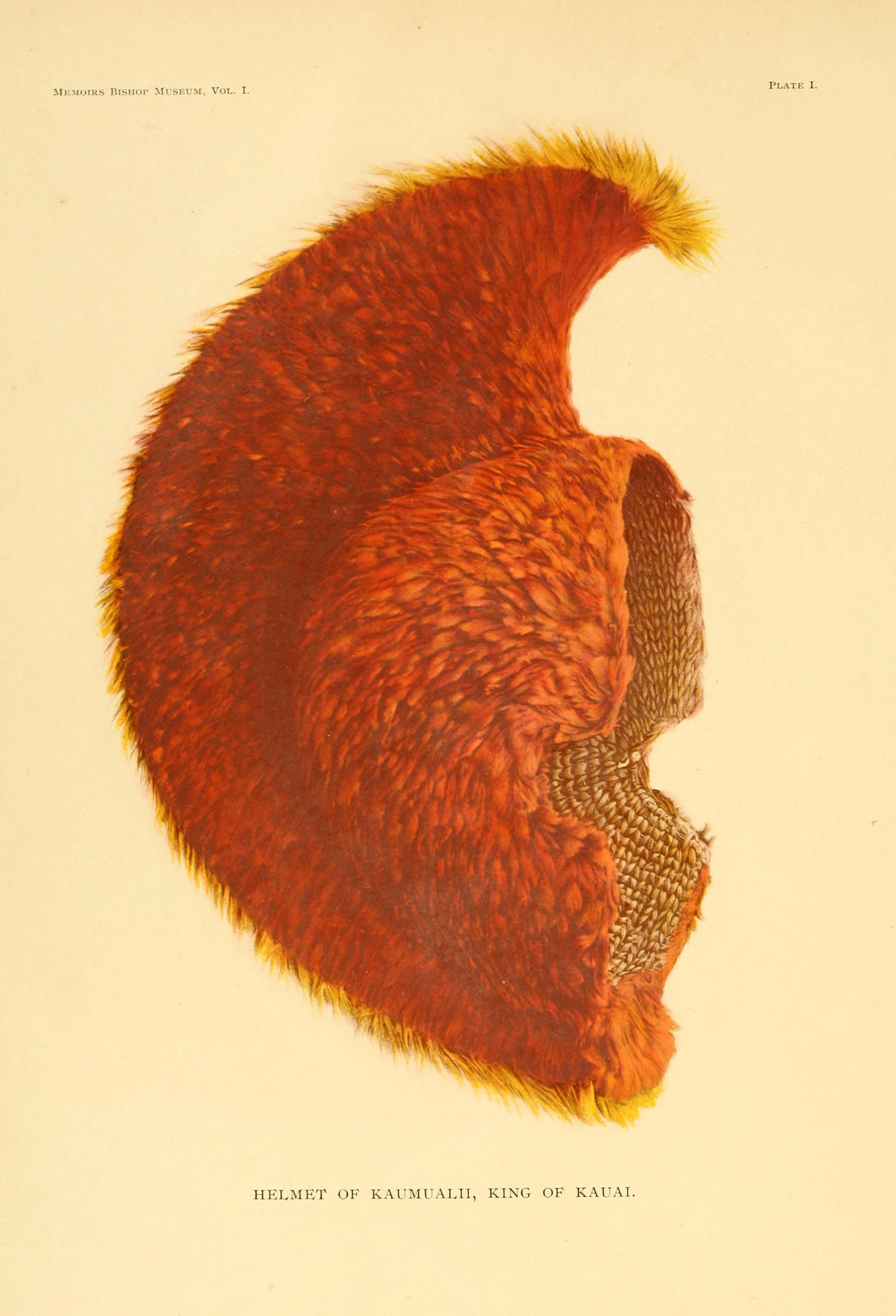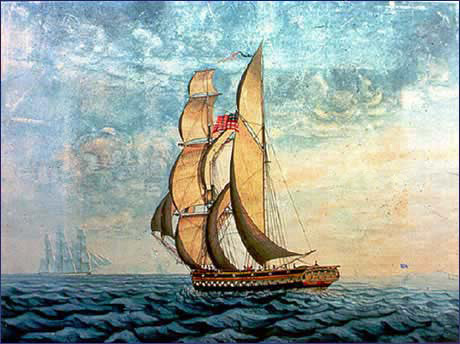|
Kaumualiʻi
Kaumualiʻi (c. 1778–May 26, 1824) was the last independent aliʻi nui (supreme ruler of the island) of Kauaʻi and Niʻihau before becoming a vassal of Kamehameha I within the unified Kingdom of Hawaiʻi in 1810. He was the 23rd high chief of Kauaʻi and reigned during 1794–1810. Although he was sometimes known as George Kaumualiʻi, he should not be confused with his son, who is more commonly known by that name. In Hanama'ulu, the King Kaumuali'i Elementary School is named after Kauai's last reigning chief. Family Kaumualiʻi was the only son of Queen Kamakahelei, aliʻi nui of Kauaʻi and Niʻihau, and her husband, Aliʻi Kāʻeokūlani (c. 1754–1794), regent of Maui and Molokaʻi. Kāʻeokūlani was the younger son of Kekaulike, the 23rd Aliʻi Aimoku and Moʻi of Maui. He became the co-king and effectively ruler of Kauaʻi by his marriage. When Kamakahelei died in 1794, she passed their titles and positions to the 16-year-old Kaumualiʻi, who reigned under the ... [...More Info...] [...Related Items...] OR: [Wikipedia] [Google] [Baidu] |
Deborah Kapule
Deborah Kapule Kekaihaʻakūlou (c. 1798–1853) was the last Queen of Kauaʻi (as wife to Kaumualiʻi) before the establishment of the Kingdom of Hawaiʻi by King Kamehameha I. Life She was born around 1798; the location of her birth is not known for certain but, since she lived around Waimea and since she received property there from her father in later life, it is assumed that this was her birthplace. Her genealogy is not well documented. According to one source, her father was a High Chief Hāʻupu of Waimea, who was one of the chiefs whom King Kaumualiʻi sent to Oahu in 1810. But according to Hawaiian historian Samuel Kamakau, her (or at least Kekaihaʻakūlou's) parents were Kaiʻawa and Hāwea. Kaiʻawa was a counselor to Kaumualiʻi's father Kāʻeokūlani and was connected to Kāneikaheilani, a chiefess from Kaua'i who was the grandmother of Haʻalou, the maternal grandmother of Queen Kaʻahumanu, and also to Kaweloamaihunāliʻi, an early King of Kauaʻi. Hāwea ... [...More Info...] [...Related Items...] OR: [Wikipedia] [Google] [Baidu] |
Hawaiian Kingdom
The Hawaiian Kingdom, or Kingdom of Hawaiʻi (Hawaiian language, Hawaiian: ''Ko Hawaiʻi Pae ʻĀina''), was a sovereign state located in the Hawaiian Islands. The country was formed in 1795, when the warrior chief Kamehameha the Great, of the independent island of Hawaii (island), Hawaiʻi, conquered the independent islands of Oahu, Oʻahu, Maui, Molokai, Molokaʻi and Lanai, Lānaʻi and unified them under one government. In 1810, the whole Hawaiian archipelago became unification of Hawaii, unified when Kauai, Kauaʻi and Niihau, Niʻihau joined the Hawaiian Kingdom voluntarily. Two major dynastic families ruled the kingdom: the House of Kamehameha and the House of Kalākaua. The kingdom won recognition from the major European powers. The United States became its chief trading partner and Hawaiian Kingdom–United States relations, watched over it to Monroe Doctrine, prevent other powers (such as British Empire, Britain and Empire of Japan, Japan) from asserting hegemony. In 1 ... [...More Info...] [...Related Items...] OR: [Wikipedia] [Google] [Baidu] |
Kinoiki Kekaulike
Kinoiki Kekaulike I was a Princess of the island of Kauaʻi during the transition from ancient Hawaii to the Kingdom of Hawaii. Biography She was born in the early 19th century. Her father was King Kaumualiʻi (1778–1824), descended from the royal family of Kauaʻi through his mother, Queen Kamakahelei and the royal family of Maui through his father Kaeokulani. Her mother was Kaʻapuwai Kapuaʻamohu, her father's stepdaughter and niece, daughter of Queen Kawalu, another wife of Kaumualiʻi being his half-sister, by her first husband, Chief Palikua of Koloa. Her mother was also granddaughter of Kamakahelei and Kaneoneo, the exiled king of Oʻahu who had been overthrown by the chiefs of Oʻahu and replaced by ʻEwa chief Kahahana. Her brother was Prince Kealiiahonui, a member of the 15 seat counsel of King Kamehameha III's House of Nobles and last prince of Kauaʻi. She married the Ali'i Nui of Hilo, Kūhiō Kalanianaʻole, son of Chief Elelule, by his wife, Chiefess Poʻoma ... [...More Info...] [...Related Items...] OR: [Wikipedia] [Google] [Baidu] |
Kamehameha II
Kamehameha II (November 1797 – July 14, 1824) was the second king of the Kingdom of Hawaii. His birth name was Liholiho and full name was Kalaninui kua Liholiho i ke kapu ʻIolani. It was lengthened to Kalani Kaleiʻaimoku o Kaiwikapu o Laʻamea i Kauikawekiu Ahilapalapa Kealiʻi Kauinamoku o Kahekili Kalaninui i Mamao ʻIolani i Ka Liholiho when he took the throne. Early life Kamehameha II was born in the month of Hanaiaʻeleʻele (corresponding to November) 1797 in Hilo, on the island of Hawaiʻi, the first born son of Kamehameha I with his highest-ranking wife Keōpuolani. It was originally planned that he would be born at the Kūkaniloko birth site on the island of Oʻahu but the Queen's sickness prevented travel. Given in care to his father's trusted servant Hanapi, who took the child to rear him in the lands of Kalaoa in Hilo Paliku, he was taken back, after five or six months, by his maternal grandmother Kekuʻiapoiwa Liliha because she felt he was not getting ... [...More Info...] [...Related Items...] OR: [Wikipedia] [Google] [Baidu] |
Russian Fort Elizabeth
Pā'ula'ula State Historical Park (Russian Fort Elizabeth) is a National Historic Landmark and is administered as the Pā'ula'ula State Historical Park just southeast of present-day Waimea on the island of Kauai in Hawaii. It is located at the site of the former Fort Elizavety (russian: Форт Елизаветы), the last remaining Russian fort on the Hawaiian islands, built in the early 19th century by the Russian-American Company as the result of an alliance with High Chief Kaumualii. The star fort was employed by the Kingdom of Hawaii in the 19th century under the name Fort Hipo ( haw, Paulaula o Hipo). History In 1815, German physician Georg Anton Schäffer, an agent of the Russian-American Company, arrived in Hawaii to retrieve goods seized by Kaumualii, chief of Kauai island.Khlebnikov, K.T., 1973, Baranov, Chief Manager of the Russian Colonies in America, Kingston: The Limestone Press, According to the company instructions, Schäffer had to begin by establishing frie ... [...More Info...] [...Related Items...] OR: [Wikipedia] [Google] [Baidu] |


